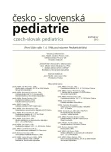Total anomalous pulmonary venous return – uncommon cause of failure to thrive in infant
Authors:
J. Radvanová 1; J. Kozák 2; P. Vojtovič 3
Authors‘ workplace:
Dětské oddělení, Nemocnice Třebíč, přísp. org.
primářka. MUDr. A. Holubová
1; Ambulance dětské kardiologie, Třebíč
2; Dětské kardiocentrum, FN Motol, Praha
primář prof. MUDr. J. Janoušek, Ph. D.
3
Published in:
Čes-slov Pediat 2012; 67 (4): 248-252.
Category:
Case Histories
Overview
Failure to thrive is common reason to visit a pediatrician or even for hospitalization. It can result from a variety of underlying causes, occasionally including congenital heart disease.
In our case report we present a 2-month old girl with total anomalous pulmonary venous return. Rapid diagnosis and surgical correction was necessary for survival.
Key words:
total anomalous pulmonary venous return, failure to thrive, heart failure, infant
Sources
1. Muntau AC, et al. Pediatrie. 4. vyd. Praha: Grada, 2009 : 293–310.
2. Šamánek M, Voříšková M. Congenital heart disease among 815,569 children born between 1980 and 1990 and their 15-year survival: a prospective Bohemia survival study. Pediatr Cardiol 1999 Nov-Dec; 20 (6): 411–417.
3. Michielon G, DiDonato RM, Pasquini L, et al. Total anomalous pulmonary venous connection: long-term appraisal with evolving technical solutions. Eur J Cardiothorac Surg 2002; 22 : 184–191.
4. Chaloupecký V. Anomálie plicních žil. In: Chaloupecký V (ed.) Dětská kardiologie. Praha: Galén; 2006 : 155–158.
5. Bleyl SB, Botto LD, Carey JC, et al. Analysis of a Scottish founder effect narrows the TAPVR-1 gene interval to chromosome 4q12. Am J Med Genet Part A 2006; 140A: 2368–2373.
6. Marek J, Tomek V, Skovránek J, et al. Prenatal ultrasound screening of congenital heart disease in an unselected national population: a 21-year experience. Heart 2011 Jan; 97 (2): 124–130.
7. Škovránek J. Péče o děti s vrozenou srdeční vadou v České republice. Kap Kardiol 2011; 3 (4): 122–126.
8. Seale AN, Uemura H, Webber SA, et al. Total anomalous pulmonary venous connection: morphology and outcome from an international population-based study. Circulation 2010 Dec 21; 122 (25): 2718–2726. Epub 2010, Dec 6.
9. Pavlíček J, Gruszka T. Vrozené srdeční vady a jejich rizikové faktory. Čes-slov Pediat 2010; 65 (11): 626–633.
10. Karamlou T, Gurofsky R, Al Sukhni E, et al. Factors associated with mortality and reoperation in 377 children with total anomalous pulmonary venous connection. Circulation 2007; 115 : 1591–1598.
11. Yun SW. Congenital heart disease in the newborn requiring early intervention. Korean J Pediatr 2011 May; 54 (5): 183–1891. Epub 2011, May 31.
12. Bernstein D. Congenital heart disease. In: Behrman RE, Kliegman RM, Jenson BH, et al. Nelson Textbook of Pediatrics. 17th ed. Philadelphia, 2004 : 1499–1554..
13. Rothman A, Galindo A, Evans WN. Temporary transumbilical stenting of the ductus venosus in neonates with obstructed infradiaphragmatic total anomalous pulmonary venous return. Pediatr Cardiol 2011 Jan; 32 (1): 87–90. Epub 2010, Oct 12.
14. Bu’Lock FA, Jordan SC, Martin RP. Successful ballon dilatation of ascending vein stenosis in obstructed supracardiac total anomalous pulmonary venous connection. Pediatr Cardiol 1994; 15 : 78–80.
15. Bando J, Turrentine MW, Ensing GJ, et al. Surgical management of total anomalous pulmonary venous connection: thirty-year trends. Circulation 1996; 95: II12–II16.
16. Yee L. Cardiac emergencies in the first year of life. Emerg Med Clin North Am 2007; 25 : 981–1008.
17. Siles A, Lapierre C. Infracardiac total anomalous pulmonary venous return (TAPVR). Pediatr Radiol 2008 Dec; 38 (12): 1354. Epub 2008, Sep 25.
18. Wukasch DC, Deutsch M, Reul GJ, et al. Total anomalous pulmonary venous return: a review of 125 patients treated surgically. Ann Thorac Surg 1975; 19 : 622–633.
19. Vignerová J, Bláha P, Brabec M, et al. Program pro hodnocení růstu dítěte. http://www.szu.cz/publikace/data/rustove-grafy [citace 1.5.2012]
Labels
Neonatology Paediatrics General practitioner for children and adolescentsArticle was published in
Czech-Slovak Pediatrics

2012 Issue 4
- What Effect Can Be Expected from Limosilactobacillus reuteri in Mucositis and Peri-Implantitis?
- The Importance of Limosilactobacillus reuteri in Administration to Diabetics with Gingivitis
Most read in this issue
- Does the postnatal detection of renal pelvis dilation a higher risk of urinary tract infection?
- Total anomalous pulmonary venous return – uncommon cause of failure to thrive in infant
- GM1 gangliosidosis associated with multiple mongolian spots
- Application of ultrasonography in the diagnostics of pyelonephritis
